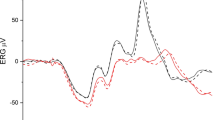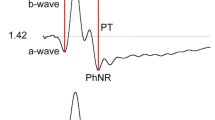Abstract
The existence of a negative ERG component following the b-wave has been known for a long time. Recently, in unilateral macaque experimental glaucoma, a negative response in flash electroretinograms under scotopic as well as photopic conditions has been shown to be greatly reduced or absent compared to the healthy fellow eye. The aim of this pilot study was to test whether a late negative electroretinogram component is reduced also in human glaucoma patients under different stimulus conditions. Dark-adapted ganzfeld flash electroretinograms were recorded after 30 min of dark using two test conditions, obtained as optimal in pilot studies on controls. Under the scotopic condition I white Xenon-flashes of intensity 0.53 Log photopic Td s were presented on a low white background of 1.38 Log scotopic Td. Under the more photopic condition II orange flashes of intensity −0.37 Log photopic Td s were presented on a blue-adapting background of 2.5 Log scotopic Td. Nine controls and 18 patients with advanced glaucoma were analyzed. The amplitude of the negative response was not significantly reduced in glaucoma patients (condition I: −28.5±23.7 μV; condition II: −25.2±19.7 μV) compared to controls (condition I: −41.4±36.6 μV; condition II: −31.3±26.2 μV). The peak latency of the responses under condition I and II did not differ significantly between patients and controls. Thus, the late negative electroretinogram component in ganzfeld flash electroretinograms obtained under scotopic and more photopic conditions does not seem to distinguish as easy between human controls and glaucoma patients as animal experiments suggest.
Similar content being viewed by others
References
Leyhecker G. The electroretinogram in glaucomatous eyes.Br J Ophthalmol1950;34: 550-4.
Francois J. L'electroretinographie dans le glaucoma.Acta Ophthalmol 1953; 31:205-18.
Schmöger B, Zimmer W. Das Elektroretinogramm bei primärem Glaukom.Klin Mbl Augenheilk1965; 146: 122-3.
Alvis DL. Electroretinographic changes in controlled chronic open-angle glaucoma.Am J Ophthalmol1966;61:121-31.
Bartl G. Das Elektroretinogramm und das evozierte Sehrindenpotential bei normalen und bei Glaukom erkrankten Augen.Graefes Arch Clin Exp Ophthalmol1978; 207:243-69.
Fazio DT, Heckenlively JR, Martin DA, Christensen RE. The electroretinogram in advanced open-angle glaucoma. Doc Ophthalmol1986; 63: 45-54.
Lowitzsch K, Welt R. VEP und Elektroretinographie durch Musterumkehrreizung in der Frühdiagnose des glaucoma chronicum simplex.Z EEG EMG1991; 22: 217-23.
Vass C, Menapace R, Gottlob I. Veränderungen des Helligkeits-Elektroretinogramms bei Patienten mit glaucoma chronicum simplex.Spektr Augenheilkd 1990; 4/6: 226-9.
Gur M, Zeevi Y, Bielik M, Neumann E.Changes in the oscillatory potentials of the electroretinogram in glaucoma. Cur Eye Res 1987;6: 457-66.
Vaegan, Graham SL, Goldberg I, Millar TJ. Selective reduction of oscillatory potentials and pattern electroretinograms after retinal ganglion cell damage by disease in humans or by kainic acid toxicity in cats.Doc Ophthalmol1991;77: 237-53.
Sieving PA, Frishman LJ, Steinberg RH. Scotopic threshold response of proximal retina in cat. J Neurophysiol 1986;56:1049-61.
Wakabayashi K, Gieser J, Sieving PA. Aspartate separation of the scotopic threshold response (STR) from the photoreceptor a-wave of the cat and monkey ERG.Invest Ophthalmol Vis Sci1988;29:1615-22.
Sieving PA, Wakabayashi K.Comparison of rod threshold ERG from monkey, cat and human.Clin Vis Sci1991; 6:171-9.
Frishman LJ, Shen FF, Du L, Robson JG, Harwerth RS, Smith III EL, Carter-Dawson L, Crawford LMJ. The scotopic electroretinogram of macaque after retinal ganglion cell loss from experimental glaucoma.Invest Ophthalmol Vis Sci1996; 37: 125-41.
Korth M, Nguyen NX, Horn F, Martus P. Scotopic threshold response and scotopic PII in glaucoma.Invest Ophthalmol Vis Sci1994;35:619-25.
Viswanathan S, Frishman LJ, Robson JG, Harwerth RS, Smith III EL. The photopic negative response of the macaque electroretinogram: reduction by experimental glaucoma. Invest Ophthalmol Vis Sci1999; 40:1124-36.
Schweitzer NMJ, Troelstra A. A negative component in the b-wave of the human ERG. Ophthalmologica 1965; 149:230-5.
Troelstra A, Schweitzer NMJ. Nonlinear analysis of electroretinographic b-wave in man. J Neurophysiol1968; 31:588-606.
Marmor M, Arden GB, Nilsson SR, Zrenner E. Standard for clinical electroretinography. Arch Ophthalmol1989; 107:816-9.
Aguilar M, Stiles WS.Saturation of the rod mechanism of the retina at high levels of stimulation.Optica Acta1954;1: 59-65.
Troelstra A, Schweitzer NMJ. An analysis of the b-wave in the human ERG.Vision Res 1963;3: 213-26.
Troelstra A, Schweitzer NMJ. On the relationship between the single flash ERG and the ERG elicited by more complex stimuli.Doc Ophthalmol 1964;18:114-27.
Author information
Authors and Affiliations
Rights and permissions
About this article
Cite this article
Cursiefen, C., Korth, M. & Horn, F.K. The negative response of the flash electroretinogram in glaucoma. Doc Ophthalmol 103, 1–12 (2001). https://doi.org/10.1023/A:1017539018387
Issue Date:
DOI: https://doi.org/10.1023/A:1017539018387




